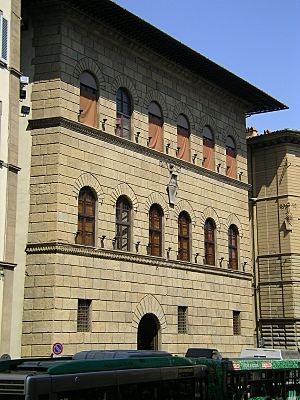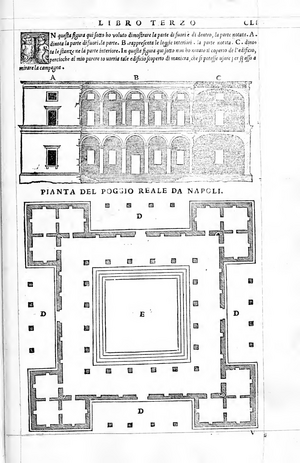Giuliano da Maiano facts for kids
Giuliano da Maiano (born 1432, died 1490) was a talented Italian architect, sculptor, and a master of intarsia (a special type of wood inlay art). He was the older brother of Benedetto da Maiano, and they often worked together on projects.
Contents
Early Life and Artistic Beginnings
Giuliano was born in 1432 in a small village called Maiano, close to Fiesole, Italy. His father was a stone-cutter. The family later moved their business to Florence. There, his father ran a stonemason's yard, creating carved stone pieces for buildings.
Giuliano showed great artistic skill from a young age. Even though his father first hoped he would become a notary (a legal professional), Giuliano's talent for sculpture and design won out.
His first important designs were for the New Sacristy of the Duomo in Florence. This work involved intricate intarsia inlay, which is like creating pictures using different colored pieces of wood. He worked on this project with his brother Benedetto between 1463 and 1465. Giuliano carved beautiful wooden designs of small angels (putti) and garlands (decorative wreaths) for the frieze (a decorative band).
He also worked with Benedetto on projects in the Palazzo Vecchio in Florence. These included a special ceiling with eight-sided sections and a white marble doorway in the Sala d'Audienza. He also created intarsia art in the Sala dei Dugento (from 1472 to 1477) and the Sala del Giglio. In 1480, he finished a special shrine for the Madonna dell'Olivo at the Cathedral of Prato, again working with his brothers Benedetto and Giovanni.
Famous Architectural Works
Giuliano became a very important architect for powerful families in Florence.
Florentine Palaces
He was almost like the official architect for the Pazzi family. He rebuilt their main home, Palazzo Pazzi, between 1462 and 1472 for Jacopo de' Pazzi.
For the Strozzi family, he added a "piano nobile" (the main floor, usually on the second level) to the Palazzo dello Strozzino around 1456. This addition was designed in a style similar to the famous Palazzo Medici-Riccardi. Many people also believe he designed the Palazzo Antinori between 1465 and 1469.
Buildings in Other Cities
In Siena, Giuliano built the Palazzo Spannocchieschi around 1475. This palace showed the Florentine style, with its slightly rough stone facade and pairs of arched windows.
Between Florence and Siena, in San Gimignano, Giuliano is known for making the Romanesque church of Santa Maria larger. He also built the chapel of Santa Fina there, working with his brother Benedetto. In Arezzo, where Benedetto built the Portico of Santa Maria delle Grazie, Giuliano built the cloister (a covered walkway) of the Badia (an abbey).
The Badia of Fiesole influenced Giuliano's design for the church of Santa Maria del Sasso, located outside Bibbiena. This church was built in 1486-87. Records show that workers sent their bills to Giuliano for his approval. The church was supported by the powerful Medici family, likely Lorenzo de' Medici himself. A large rock, where people believed the Virgin Mary appeared, rises through the floor of the church. Giuliano designed a delicate domed structure called a baldachin to mark and protect this special spot.
Projects in Rome and Naples
Giuliano's excellent reputation led to commissions in other important cities. He worked in Rome, Loreto (on the Basilica della Casa Santa), and Faenza (on the cathedral from 1474 to 1486). He also worked in Recanati, where Lorenzo de' Medici sent him to build Palazzo Venier for Cardinal Anton Giacomo Venier.
From 1487, Giuliano worked mainly in Naples. Alfonso, who was then the Duke of Calabria, hired him to work on the Villa di Poggio Reale (1487–1488). Sadly, this villa was later torn down.
Giuliano also built the marble Porta Capuana in Naples. This gate was flanked by two round towers of the Castello. It looks like a triumphal arch with Corinthian columns and many sculptures. Inside the Sala Grande of the Castello, he carved detailed bas-reliefs (sculptures that stick out slightly from a flat surface) above the doors.
Giuliano da Maiano died in Naples in 1490. Alfonso himself made sure there were mourners at his funeral, showing how much he respected Giuliano.
Giuliano was also famous for a wooden room entirely made of intarsia, known as the "Studiolo," in the Ducal Palace in Gubbio.
See also
 In Spanish: Giuliano da Maiano para niños
In Spanish: Giuliano da Maiano para niños




